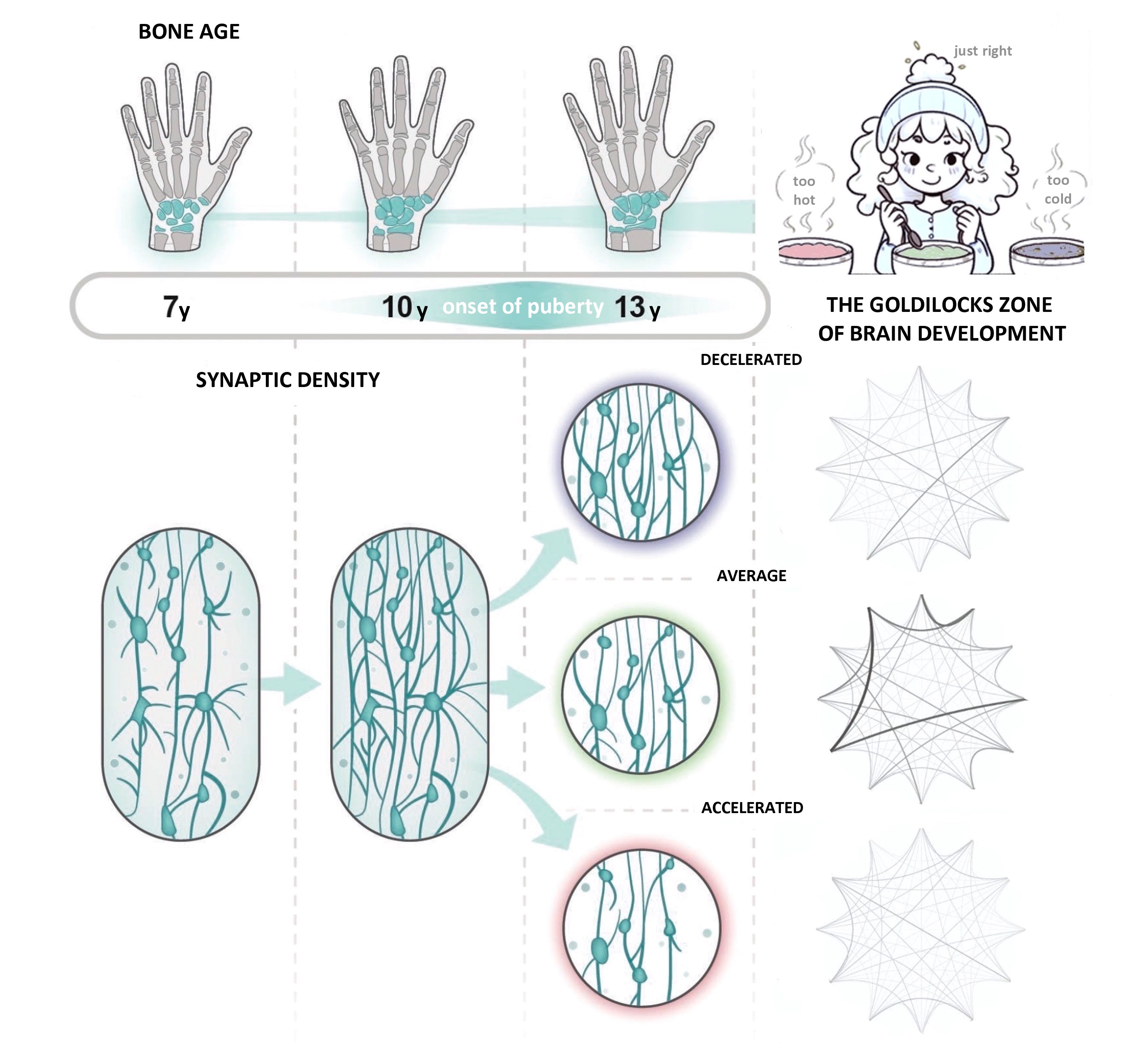The Goldilocks Zone Of Brain Development

An important element in the children’s fairy tale entitled ‘Goldilocks and the Three Bears’ is the porridge with just the right temperature. This concept has been adopted by scientific thinking, as well. The ‘Goldilocks zone’ also called ‘habitable zone’, for example, has been defined to mark the range of planetary orbits around a star within which life may develop.
In an analysis of cortical organisation based on thermodynamic principles, the HUN-REN-ELTE-PPKE Adolescent Development Research Group (Serdülőkori Fejlődés Kutatócsoport, SFK), in collaboration with researchers from Pompeu Fabra University (Barcelona) and the University of Oxford, has now revealed that there is also an optimal zone for the progression of hierarchical organisation in the brain, where the pace of maturation is neither too fast nor too slow, but just right.
Ilona Kovács and Ferenc Gombos, researchers from SFK, and Hanna Szakács, a scientist from Pázmány Péter Catholic University (Pázmány Péter Katolikus Egyetem, PPKE)
have recently introduced ultrasound bone age assessment into adolescence research,
which provides a much more accurate estimate of adolescent maturity than ever before. This is important because puberty not only signifies maturation but also triggers a major reorganisation in the cerebral cortex and behavioural transformation from a child to an adult. The onset of puberty may vary widely.
The study on brain development compared three groups of adolescents with different levels of maturity. The members of the average group had a bone age that corresponded to their chronological age, while those in the decelerated group had a lower bone age, and those in the accelerated group had a higher bone age than their chronological age. The question was whether the level of cortical hierarchical organisation differed among the groups of varying maturity.
Brain development was monitored using high-density resting-state electroencephalography (HD-EEG), which records the default mode network (DMN) of the brain. This network is particularly active when the brain receives few external stimuli and has no specific action goals. This type of intrinsic activity is crucial for adaptation to the environment, as well as for its interpretation and prediction.

Figure 1: The Goldilocks zone of brain development
The level of organisation of the default mode network was interpreted within a theoretical framework borrowed from thermodynamics. The Second Law of Thermodynamics states that material systems tend to transform irreversibly from order to disorder over time. As disorder increases, so does “entropy production”, which, in living systems, refers to the directional, non-reversible flow within the state space of their components. Applied to the microstates of the brain, this implies that transitions between states occur asymmetrically, according to an organised hierarchy.
The results show that age does not play a prominent role in entropy production, whereas the level of maturity is decisive. Surprisingly, however,
entropy production is not directly proportional to the degree of maturity.
Based on HD-EEG, the highest estimated entropy value has been observed in the group with average maturity, where bone age corresponds to chronological age. In this group, which seems to have the most optimal organisation of cortical hierarchy, the onset of puberty and the tempo of maturation are neither slow nor fast, but proceed at an average pace corresponding to the so-called secular trends.
One of the possible interpretations is related to the synaptic density depicted in the left panel of Figure 1. The density of connections between cortical neurons gradually increases during childhood, followed by an intensive synaptic “pruning”, which is an opposite process initiated at the onset of puberty. It is hypothesised that this process shapes the existing neural connections into networks characteristic of adults. Supposedly, if pruning begins too early (accelerated), the synaptic density becomes too low (“overpruned”). If, however, it starts too late (decelerated), the synaptic density remains excessively high (“underpruned”). Both scenarios may be associated with more symmetric transitions in the brain’s microstates (Figure 1, right panels: the thicker and darker a line, the more asymmetric the transition between two microstates).
Although it is not yet clear whether the measured maturity-dependent differences persist into adulthood, the results presented above suggest that investigation into the educational and clinical implications of the suboptimal maturational pace may be of paramount importance.
Our previous interview with Ilona Kovács is available on this link. You can watch her presentation (in Hungarian) on the topic below:

